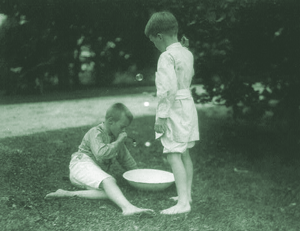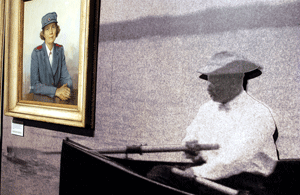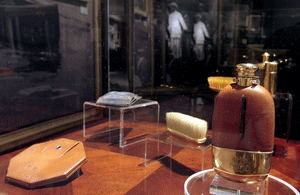
Lovely Life
Edith Roosevelt liked being First Lady. She had more time to spend with her husband, and his salary of $50,000 removed the usual money worries that had plagued the family. She was nervous, however, over a possible assassination attempt on her husband. Theodore began to carry a pistol, stating “If a man is willing to give his life for mine, there is no way that he can be prevented from making the attempt. But such a man must be quicker than I am in the use of his gun.” Maybe another concern should have been over her children, undoubtedly the rowdiest brood to ever occupy the White House.
The Roosevelts were a young family and brought to the White House a robust family of six children between the ages of four and 17. Sometimes counted as a seventh child was TR himself, who frolicked with the kids. “I play with the children almost every night and some child is invariably fearfully damaged in the play; but this does not seem to affect the ardor of their enjoyment.”
Alice, TR’s oldest child, and her father were frequently at odds. “Father doesn’t care for me, that is to say one eighth as much as he does for the other children,” a sentiment born when Teddy abandoned her for the Dakota Badlands. She was the most outgoing and contrary of all the kids, not unlike her father. When a friend asked TR if he could do something to control Alice he replied, “I can do one of two things. I can be President of the United States or I can control Alice. I cannot possibly do both.” When a deranged man came to Sagamore Hill carrying a pistol, saying he was going to wed Alice, TR said, “Of course he’s insane. He wants to marry Alice.” In 1906, Alice was wed in the White House to Nick Longworth, in a ceremony absent of bridesmaids, because Alice did not want to share any attention that day. It was ironic that Alice later described her father as wanting to be the bride at every wedding and the corpse at every funeral.
Namesake Theodore Jr. was a spitting image of his father in looks and manners. Much was expected of him but he could hardly live up to the standards of being TR’s oldest son. He shunned the attention Alice and his father craved and did not do as well at Harvard as the old man. Knowing how sensitive his son was to criticism, TR wrote, “Good luck, old boy! You’ll come out all right. I know you have the stuff in you, and I trust you entirely.” In later years, TR Jr. embarked on a military career that earned him the rank of General and a Congressional Medal of Honor for heroics at the Normandy invasion in World War II.
Second son Kermit was once described by his father as “a solemn, cunning mite, with queer little friends.” He followed his father and brother Ted to Harvard but he had a love of adventure, traveling to dangerous spots, and became an avid hunter. He would later travel with TR on African safari and expeditions to South America. At the outbreak of World War I, he joined the British army, later enlisting in the U.S. Army.
Daughter Ethel was less rambunctious than her siblings but a darling in TR’s eyes. He once said she was a “small, motherly home-body.” During World War I she enlisted as a nurse in a Paris hospital where her physician husband also served. Son Archie was a “sweet-tempered little fellow, not at all combative” like his older brothers. Archie served as captain in the army in World War I and was severely wounded, later becoming a prosperous Wall Street banker.
Youngest son Quentin was probably the most disrespectful of authority, and his parents knew he was a handful. To Quentin’s teacher TR wrote, “Mrs. Roosevelt and I have no scruples whatever against corporal punishment …. If you find him defying your authority or committing any serious misdeed, then let me know and I will whip him.” Despite his rebellious nature, Quentin was loved as the baby of the family. Tragically, Quentin, a pilot in World War I, was shot down and killed, one of the lowest points in the lives of his parents.
image of Quentin and Archie Roosevelt, coutesy of Library of Congress
return to Ford
Presidential Library and Museum
other Museum
on-line exhibits
relevant links:
Edith
Roosevelt
White House
Theodore Roosevelt Jr.
Congressional Medal of Honor
Normandy Invasion, World War II
Kermit Roosevelt
Ethel Roosevelt
Archie Roosevelt
Quentin Roosevelt
World War I

Installation view of exhibit, and upper left: Oil painting of Ethel, Theodore and Edith Roosevelt’s third child, in a World War II nurse’s uniform. Loan Courtesy of the Sagamore Hill National Historic Site, National Park Service, U.S. Department of Interior.

Items from Theodore Roosevelt’s toiletry case. Includes hair brush, hat brush, tooth powder holder, flask, manicure set, shaving set, shaving mirror, and jewelry case. Loan Courtesy of the National Museum of American History, Smithsonian Institution, Washington, D.C.
![]()